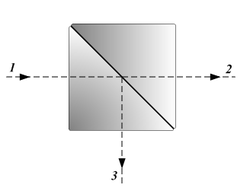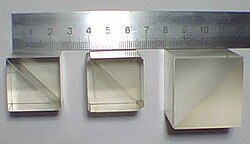Beam splitter
A beam splitter is an optical component that separates a single light beam into two partial beams. This property makes the beam splitter, among other things, the central component of different types of interferometers . Furthermore, there are beam splitters u. a. in binocular attachments, for optical distance measurement, in alignment lasers or in laser telescopes for satellite geodesy.
A very simple beam splitter is a pane of glass that is inserted into the beam path at an angle of 45 ° . Part of the light is reflected on the surface of the pane at an angle of 90 ° , while another part penetrates the pane. By applying a suitable partially reflective coating to the surface of the pane, the beam can be divided into two beams of equal intensity ( semi-transparent mirror ) .
In its common form, a beam splitter consists of two prisms that are cemented together at their base (e.g. with Canada balsam ). The principle by which a beam splitter cube works is total reflection prevented . The division ratio is therefore dependent on the wavelength of the light. The thickness of the resin layer determines the ratio with which the incident light beam is divided.
In addition to non-polarizing beam splitters, there are also polarizing beam splitters (also called polar cubes ). The splitting ratio is determined here by the polarization angle of the incoming light. Pole cubes are used in laser technology to set exact division ratios. Conversely, two polarized light beams can be combined with one another.
Jones formalism
Like all optical components, the beam splitter has an associated matrix in the Jones formalism .
For a lossless beam splitter (neither dispersion nor absorption) applies:
where r and t are (generally complex) reflection and transmission coefficients, respectively. E 1 , E 2 and E 3 , E 4 are complex numbers that describe the phase and amplitude of the incoming and outgoing light rays. From the conservation of energy it follows that the matrix must be unitary .
For the special right-angled case (50:50 division of the intensity):
Reflection beam splitter

Pure reflection beam splitters reflect parts of the incident radiation in different directions. By suitably designing the reflectors, exactly the same intensities of the individual partial radiation bundles can be achieved. Such beam splitters are used, among other things, in optical radiation detectors . The radiation entering through the aperture opening of the imaged detector is separated at highly reflective microstructures within the detector into several beams of radiation of the same intensity but different directions. The bundles then each hit a sensor element with an upstream optical filter. This minimizes differences between the measuring channels and the necessary beam cross-section.
literature
- Eugene Hecht: optics . 4th edition. Oldenbourg, Munich, Vienna 2005, ISBN 3-486-27359-0 , pp. 214 ff . (American English: Optics . Translated by Dr. Anna Schleizer).
Individual evidence
- ↑ a b Frank Träger: Springer Handbook of Lasers and Optics . Springer, Berlin Heidelberg 2012, ISBN 978-3-642-19409-2 , p. 1265 (English, limited preview in Google Book search).
- ↑ Beam splitter. www.infratec.de, accessed on November 2, 2016 .





